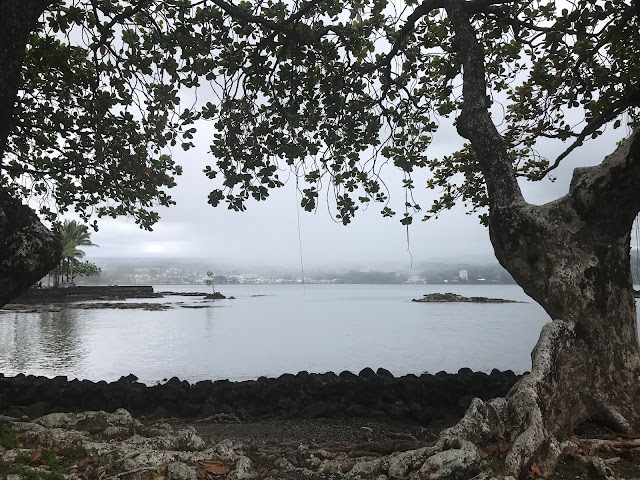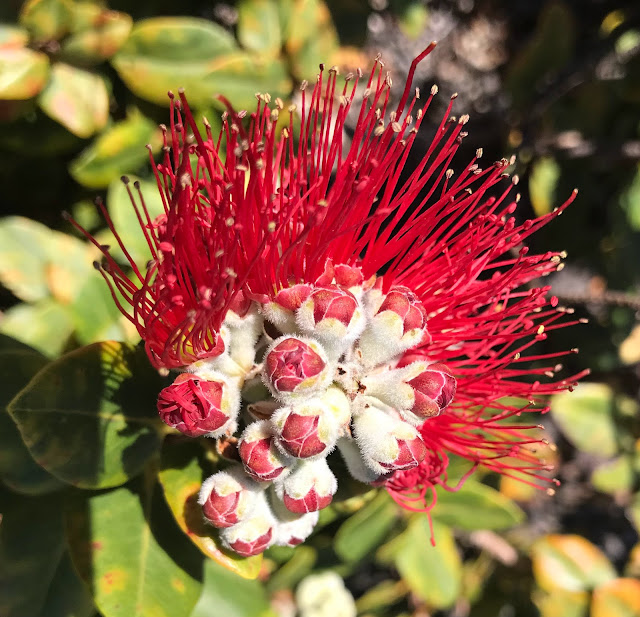Drought in the uplands of Keaʻau...not all that unusual, but surprising to some. Tankers deliver to those unaccustomed to prudent and careful use of water in this place of (usually) abundant rains. As of a couple weeks ago, year-to-date rainfall in Volcano was just about 3.5 inches, compared to about 32 inches in December alone. Weʻve appreciated the time of drying out after our December torrents. Down Ke Alanui Pae Luapoho (Chain of Craters Road) on the coast, plants are happy, green, and lush, unaccustomed as they are to an abundance of moisture.
Mid-January, friends and I visited in the parking lot next to Mokuola. Across Kūhiō Bay we enjoyed watching Ka ua kanilehua sweep along the lowlands as it came in from Leleiwi. The branches of old tropical almond trees overhead provided additional interest.
Too, at the shore that day, across the street from Liliʻuokalani Gardens, reminders of the catastrophic eruption of Hunga Tonga and Hunga Haʻapai in Tonga and its associated tsunami on January 15, 2022. "Hunga" means a small rocky islet, and the archipelago of Tonga is 3,100 miles to our southwest.
In another direction, 7,000 miles southeast of Hawaiʻi nei, is Torres del Paine. From Wikipedia:
Climber friends have been there, as have non-climber friends when they visited
Patagonia in the south of Chile, near their version of Kalae.
Iʻve always been struck by the dramatic landscape there. Aside from the soaring towers of granite, that blue of the lake is a favorite. Below, first from National Geographic, then from WikiMedia.
And, perhaps because of my visual proclivities, I was reminded of the shapes of the Torres as I looked at the graph of tilt of Kaluapele:
Up Down Up downup DOWNDOWN... And as weʻve come to understand, the measurement of Tilt is a reflection of the activities (or lack thereof) of Pelehonuamea. Today, she was active till dawn, then went into decline. Iʻm kinda obsessive about saving screenshots of webcams, because in the short term they illustrate the sometimes subtle changes in Halemaʻumaʻu. The word loli in "Hoʻololi" is applicable:
1. vt. To change, alter, influence, turn, turn over. Loli wale, to change for apparently no reason or whimsically; variable. Loli ʻana, change, conversion, variation, evolution. Loli aʻe, to vary, change. hoʻo.loli To change, convert, exchange, alter, transform, take a new form, amend; amendment, change. Hoʻololi i ka lole, change clothes. Hoʻololi ʻōlelo, amend, decline, conjugate. Hoʻololi i ka manaʻo, to change the mind. Hoʻololi mai i ka noi, to amend a motion. Hoʻololi kālā, currency exchange.
2. n. Sea slug, sea cucumber, beche-de-mer, trepang (Holothuria spp.); for some people an ʻaumakua. See kūkaeloli and saying, ʻīloli. (PPN loli.)
3. vs. Spotted, speckled, daubed; to color in spots, as tapa. Cf. īloli 2.
Below, from December 30, 2021. The increase from 246p to 356p is dramatic.



Below, lower left is a little puʻu-ish structure, built over a persistent pond, a loko ahi liʻiliʻi. Pele is active in the bottom, exits via a tunnel (the bright triangular area) and slowly flows through a glowing māwae (channel or ditch) making her way to the bigger loko ahi.
When pele increases activity after a respite, we often observe a gushing flood. The brightest area, toward the bottom right is the location of the notched lua above.
Similar view angle below...
Fascinations are endless. Lehua are coming into bloom. The rarer lehua mamo is always a treat.
The pic below interests me because the just-opened pua bottom left, is unfurling its lihilihi (stamens). Apologies for blurriness, but the pollen-bearing anthers at stamen tips have not yet revealed their yellow pollen seen on the second photo below.
The update above, for this morning, was written as the activity of pele was slowing considerably. I happened to be on the rim at sunrise, watching. Three webcam screenshots below, just now...

Below, still a bit of glow in the loko ahi liʻiliʻi, lower left.
Come visit! No matter if Pele is very busy or taking a break, itʻs all good. Koaʻe kea (and the occasional ʻio) soar; ʻapapane, ʻamakihi, and ʻōmaʻo call; lehua bloom, and winds, variable in direction, strength, and temperature, blow and/or waft. Mist, sun, hot, chill...take a break from quotidian tasks, breathe deeply, and exhale slowly.
As always, with aloha,
BobbyC




















Aloha e ke hoa! He pule hoʻōla kēia nou, me ka mahalo ā nui ia ʻoe!
ReplyDelete